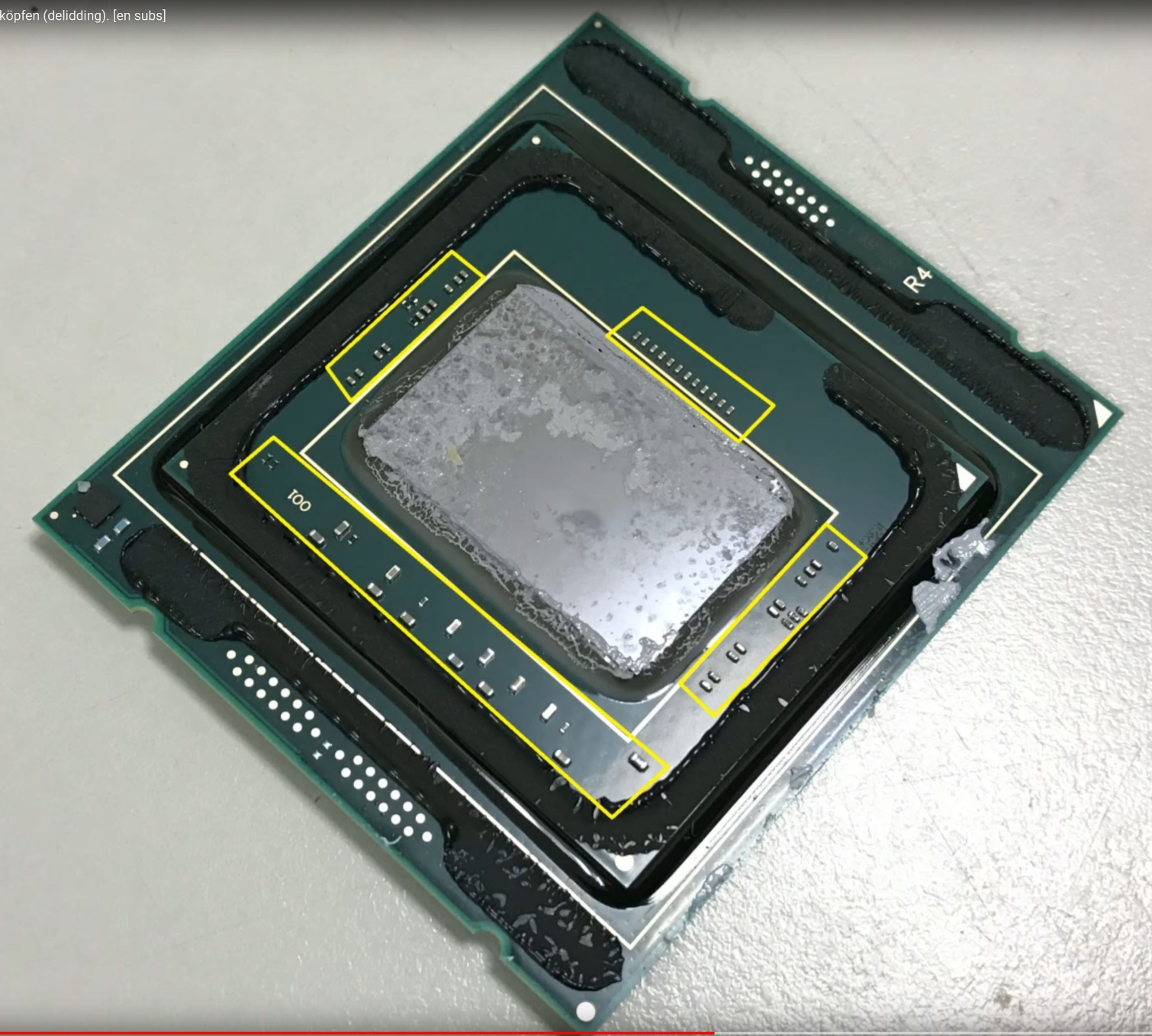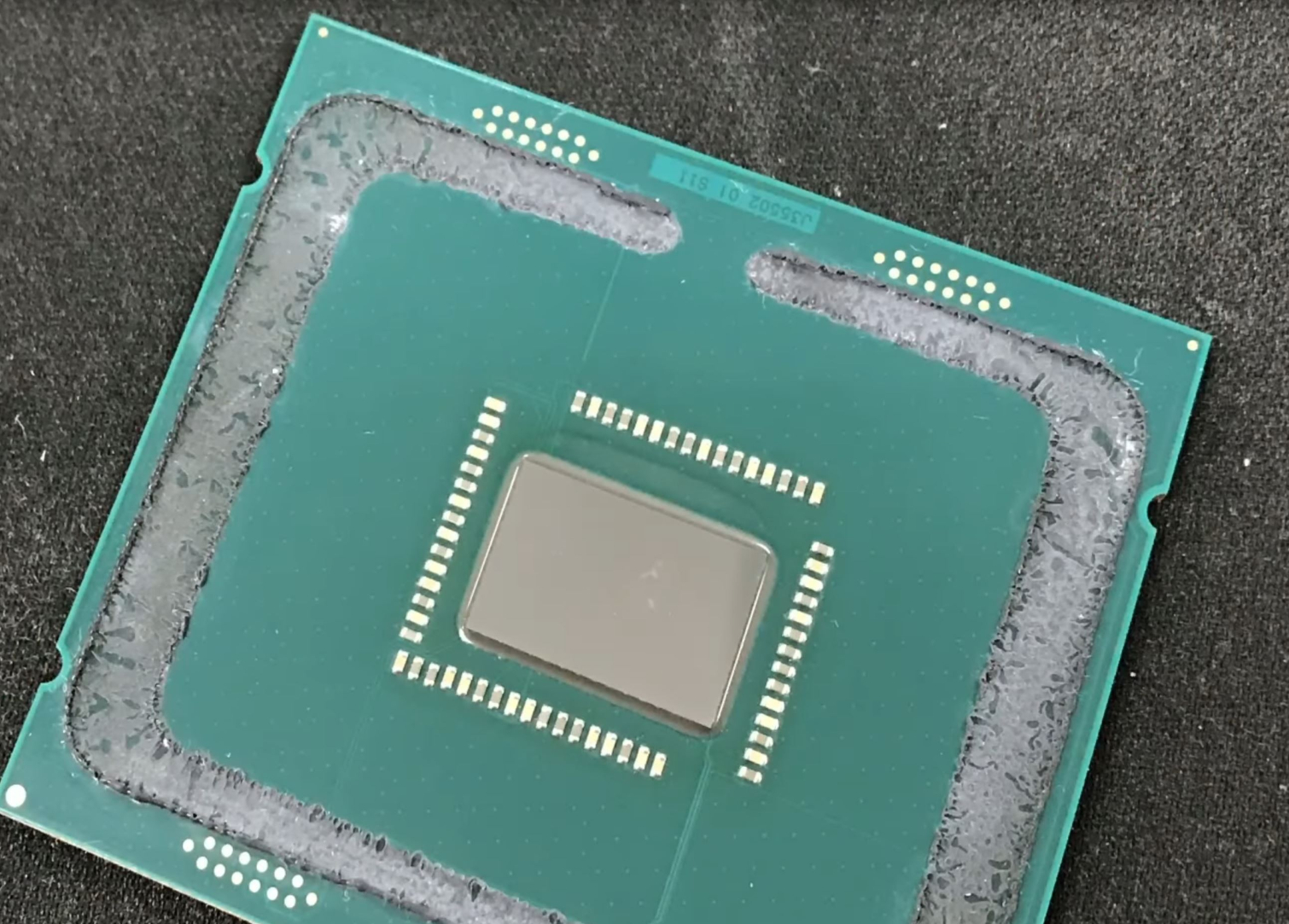Intel Core i9-7920X Delidded, Massive HCC Die Exposed
Roman Hartung, otherwise known by his overclocking handle Der8auer, delidded an $1,100 i9-7920X and posted pictures to his Facebook account. Intel originally slated its new 12C/24T i9-7920X for release August 28, but the chips didn't appear at retailers until roughly a week later. In either case, it isn't surprising to see one of Intel's latest Skylake-X processor make it onto Der8auer's test bench, but the size of the massive die does give us a few clues as to what lurks underneath.



The Core i9-7920X is the first photo in the series. The die rests on an interposer (the topmost PCB), which Intel connects to another underlying PCB. That layered design makes delidding Skylake-X chips more difficult than delidding a "regular" chip. Typically, you can use a simple razor blade to pop off the IHS (Integrated Heat Spreader), thus exposing the die. However, the stacked interposer introduces another layer of glue to the design, so you have to use a dedicated delidding tool.
As always, proceed at your own risk; delidding is risky and known to destroy processors. However, delidding allows you to swap out the TIM under the IHS, thus gaining some much-needed overclocking headroom.
We don't see any solder residue around the die, so it appears that Intel is sticking with its oft-maligned thermal paste. That means we can expect similar cooling problems that we've seen with other Skylake-X models. We dove in deeper in our Skylake-X Mess Explored: Thermal Paste And Runaway Power article.
Intel's ten-core i9-7900X is pictured in the second slide, and the last slide is a Kaby Lake-X processor. The 7920X's die is much larger than the other two processors, whereas the Kaby Lake-X models use the same die we find on Intel's mainstream processors, but they all snap into an LGA 2066 socket. The interposer allows Intel to mix and match different die into the same socket.



Intel's Skylake-X die come in LCC (Low Core Count), HCC (High Core Count), and XCC (eXtreme Core Count) flavors. The lower-end Skylake-X models, like the Intel Core i9-7900X we recently reviewed, use the 10-core LCC die. Intel disables cores along the way to create the six-core and eight-core models.
Stepping up to more cores, such as Intel's forthcoming 18C/36T i9-7980XE, requires the HCC die. That means Intel's flagship will look the same under the hood as the i9-7920X pictured above.
Get Tom's Hardware's best news and in-depth reviews, straight to your inbox.
Intel is, unsurprisingly, sticking to using thermal paste under the 7920X's heatspreader, and we suspect the same for the flagship 18C/36T model. That will pose a serious challenge to even the most accomplished overclockers, as poor thermal dissipation from the die is impossible to completely surmount, even with exotic cooling solutions. Intel also released new microcode for its Skylake-X processors recently, which reduces performance in some titles and lowers the AVX offset by two bins, which is likely designed to address the recent thermal issues.
In either case, we'll be able to share details on cooling in the near future, as the rest of the Skylake-X models are coming to market soon.

Paul Alcorn is the Editor-in-Chief for Tom's Hardware US. He also writes news and reviews on CPUs, storage, and enterprise hardware.
-
John Nemesh The lack of solder is the main reason I am not choosing Intel for my next build! This may be a cost cutting move or a decision meant to get the processors on the market faster, but I find the lack of solder inexcusable on a high end chip! I was HOPING this was only a temporary move...in order to launch the new processors fast in response to Threadripper...but it looks like they are sticking with what doesn't work, so I will be shopping elsewhere. I am NOT going to delid a processor just to cool it effectively!Reply -
I heard that Intel doesn't use solder because their manufacturing process no longer allows it, i.e. they no longer have the machines to do it. It was a choice to save money. They would have to retool, and that would cost X of millions, and extra costs for each chip.Reply
-
InvalidError TIM would be fine if Intel reduced the TIM thickness.Reply
Since Intel does not officially condone overclocking beyond making it possible for a fee, it doesn't have much of an obligation to go out of its way to enable more of it than what it needs to gouge people for the privilege. (And even fewer reasons to bother with the manufacturing complications it brings when the competition has next to no overclocking headroom to speak of to begin with.) -
jasonelmore The solder is a environmental impact thing, not a cost thing. i agree tho, in these low volume parts, they should use solderReply -
bananaforscale Reminds me a bit of the issue with 1 GHz+ Pentium 3s. They couldn't get them to work reliably.Reply -
InvalidError Reply
Both work, only depends on how you decide to pronounce it: "An eleven hundred dollars CPU"20151652 said:"delidded an $1,100" - "a $1,100" not "an $1,100" ;) -
ElMojoMikeo I am looking forward to the next review update. As a result of the last Skylake X reviews on here I have been looking at cooling across the board in some detail. The IHS of course came up as the main culprit. Some crazy ideas on that thread alone helps you to look at things differently.Reply
The exotic zero cool technologies with a fridge compressor and the whole shabang! They are great, until I watched a video on how to install it. I will not be doing that until I have practiced it many times over the next year. I don't think that even the mainstream overclockers are ready for such a challenging build. Add to that a life threatening big bang if the compressor leaks and delidding with condensation around a bigger risk.
One thing that became clear is that cooling as we have it now is limited. As I said back on that thread the problem is not new I have struggled to cool X processors with high 150W TDP at base clock for years.
I remain optimistic now that the new Skylake X processors are running hot too, that I will get a new solution to an old problem. I am currently writing an AIO driver for what could be termed a modest step forward. But the lack of coordination from Microsoft and Intel in particular has led to ad hoc drivers badly crafted and all seem to break each other. I can see several good solutions to these problems if the manufactures would just work together, to some degree at least.
I didn't look at any of these issues before the Skylake X Thermal review. I found my fans were actually running free some of the time because the Corsair Link software was broken. The boot up sometimes failed to find the hardware but no warnings were issued. Corsair USB Bridge driver doesn't work with Microsoft USB Bridge driver without which you get general USB hub problems. All of these are affected adversely by ASUS AI suite too. Yes even the OEM has not provided a reliable platform for cooling. All using ad hoc access to the MSR and reducing my system reliability.
With the exception of SIV64 I have removed the lot. The cooling is now working as it should be! If we are going to get better and more sophisticated cooling then it might be time to clean up the Wild West.